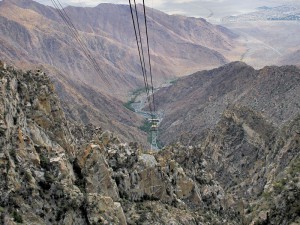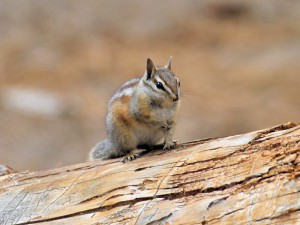During a recent visit from family, we took the famous Palm Springs Aerial Tram up to Mountain Station (see photo of Mountain Station here), the entrance to Mt. San Jacinto State Park. The ride is quite dramatic. It rises 6000 feet from a dry desert bottom to 8516 feet at Mountain Station, in under 15 minutes. The Swiss-made aerial tram cars have a rotating floor so that passengers get the full panorama during their climb without jostling for position. Once you arrive at Mountain Station, you have a choice of activities. You can visit the gift shop, catch a snack or a meal at the Peaks Restaurant. Alternatively, exit into Long Valley and take some of the hiking trails in the state park. We ended up doing all three of those.
There are two short interconnected loop trails in Long Valley itself. Both the 0.75-mile Long Valley Discovery Trail and the 1.5-mile Desert View Trail are there. If you do both of those, because they connect in the middle, the total distance is just over two miles. Both trails are moderate to easy terrain for walking. There are 54 miles of trail accessible from this site. So if you want more strenuous hikes, those are readily available. We did the two shorter trails. We stopped for the panoramic vistas of the Desert View Trail north towards the Morongo Valley, and northeast, out over Indio and the Coachella Valley. On the Discovery Trail, we found quite a few more of the mountain birds and animals available at this site.
Panhandlers and Freeloaders!
The area is not without its dangers, however. The most significant risk is of panhandlers like this Lodgepole Chipmunk. Chipmunks use a potent mixture of petiteness and cuteness to wheedle food out of unsuspecting visitors. Nor is that the only type of freeloader present here. The California Ground Squirrel (see one here) uses a very up-front strategy of begging and posturing. State Park signs warn strongly against feeding these guys, but we saw lots of people doing it anyway. The Stellar’s Jay, easily the most charming rogue of them all, represents another serious hazard. Unlike the other predators, jays “attack” in packs once a generous food source makes itself apparent.
Local Birds
Once up and walking around, we saw and heard a lot of the normal southern California mountain bird cohort. Easiest to hear but difficult to actually see, Pygmy Nuthatches, vocalized often but but stayed well up in the trees. The Oregon race of Dark-eyed Junco was also common there. Violet-green Swallows flew through occasionally, and Western Bluebirds were common all over. The House Finches tended to stay right around the lodge. We saw Mountain Chickadees feeding their fluttering begging young in several places. More uncommon birds included Brown Creepers, White-breasted Nuthatches, Western Wood-Pewees and at least one American Robin. White-headed Woodpeckers were fairly common in the trees over Long Valley; we saw or heard several. One nice surprise was a Green-tailed Towhee that was feeding on the ground, but flew up into the pines when startled (see photo here).
Other creatures we observed included lots of Western Fence Lizards up on top, and this handsome Granite Spiny Lizard (see photo here), appropriately perched on a granite rock face at the lower terminus of the aerial tram.



